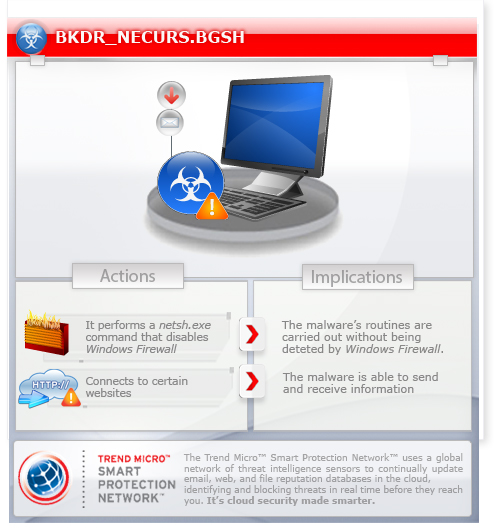BKDR_NECURS.BGSH
Mal/Cridex-F (Sophos) ,Trojan horse Pakes_c.BEQF (AVG) ,W32/Necurs.TFT!tr (Fortinet) ,Trojan.Win32.Pakes (Ikarus) ,Trojan-Dropper.Win32.Necurs.tft (Kaspersky) ,Trojan:Win32/Necurs (Microsoft) ,Generic Dropper.p (McAfee) ,a variant of Win32/Kryptik.BWCR trojan (Eset) ,Generic (Panda) ,Trojan.Win32.Generic!SB.0 (Sunbelt)
Windows 2000, Windows Server 2003, Windows XP (32-bit, 64-bit), Windows Vista (32-bit, 64-bit), Windows 7 (32-bit, 64-bit)


Threat Type: Backdoor
Destructiveness: No
Encrypted: Yes
In the wild: Yes
OVERVIEW
This malware runs a certain command that disables Windows Firewall depending on the operating system version. It elevates certain privileges when not in Admin mode.
To get a one-glance comprehensive view of the behavior of this Backdoor, refer to the Threat Diagram shown below.

This backdoor arrives on a system as a file dropped by other malware or as a file downloaded unknowingly by users when visiting malicious sites.
It executes then deletes itself afterward. It is injected into all running processes to remain memory resident.
It modifies registry entries to disable the Windows Firewall settings. This action allows this malware to perform its routines without being deteted by the Windows Firewall.
It connects to a website to send and receive information. However, as of this writing, the said sites are inaccessible.
It creates an event.
TECHNICAL DETAILS
Arrival Details
This backdoor arrives on a system as a file dropped by other malware or as a file downloaded unknowingly by users when visiting malicious sites.
Installation
This backdoor drops the following file(s)/component(s):
- %System%\drivers\{random}.sys
(Note: %System% is the Windows system folder, which is usually C:\Windows\System32.)
It drops the following copies of itself into the affected system:
- %Application Data%\{random GUID}\syshost.exe - if not logged in as an Administrator
- %Windows%\Installer\{GUID}\syshost.exe - if logged in as an Administrator
(Note: %Application Data% is the current user's Application Data folder, which is usually C:\Documents and Settings\{user name}\Application Data on Windows 2000, XP, and Server 2003, or C:\Users\{user name}\AppData\Roaming on Windows Vista and 7.. %Windows% is the Windows folder, which is usually C:\Windows.)
It creates the following folders:
- %Windows%\Installer\{random GUID} - if logged in as an Administrator
- %Application Data%\{random GUID} - if not logged in as an Administrator
(Note: %Windows% is the Windows folder, which is usually C:\Windows.. %Application Data% is the current user's Application Data folder, which is usually C:\Documents and Settings\{user name}\Application Data on Windows 2000, XP, and Server 2003, or C:\Users\{user name}\AppData\Roaming on Windows Vista and 7.)
It executes then deletes itself afterward.
It is injected into all running processes to remain memory resident.
Autostart Technique
This backdoor registers itself as a system service to ensure its automatic execution at every system startup by adding the following registry entries:
HKEY_LOCAL_MACHINE\SYSTEM\CurrentControlSet\
Services\syshost32
ImagePath = ""%Windows%\Installer\{GUID}\syshost.exe" /service"
It creates the following registry entries to enable automatic execution of dropped component at every system startup:
HKEY_LOCAL_MACHINE\SOFTWARE\Microsoft\
Windows\CurrentVersion\Run
syshost32 = %Windows%\Installer\{GUID}\syshost.exe
It registers as a system service to ensure its automatic execution at every system startup by adding the following registry keys:
HKEY_LOCAL_MACHINE\SYSTEM\CurrentControlSet\
Services\syshost32
It registers its dropped component as a system service to ensure its automatic execution at every system startup. It does this by creating the following registry entries:
HKEY_LOCAL_MACHINE\SYSTEM\CurrentControlSet\
Services\{random}
Other System Modifications
This backdoor modifies the following registry entries to disable the Windows Firewall settings:
HKEY_LOCAL_MACHINE\SYSTEM\ControlSet001\
Services\SharedAcces\Parameters\
FirewallPolicy\DomainProfile
EnableFirewall = "0"
(Note: The default value data of the said registry entry is "1".)
Backdoor Routine
This backdoor connects to the following websites to send and receive information:
- http://{BLOCKED}.{BLOCKED}.81.244
- http://{BLOCKED}.{BLOCKED}.195.245
- http://{BLOCKED}.{BLOCKED}.56.54
- http://{BLOCKED}.{BLOCKED}.31.41
However, as of this writing, the said sites are inaccessible.
Other Details
This backdoor connects to the following URL(s) to check for an Internet connection:
- facebook.com
- microsoft.com
It creates the following event(s):
- Global\NitrGB
- Local\NitrGB
NOTES:
It performs a netsh.exe command that disables Windows Firewall depending on the OS version. It elevates certain privileges when not in Admin mode.
It connects to the following time servers to synchronize time:
- 0.pool.ntp.org
- 1.pool.ntp.org
- 2.pool.ntp.org
SOLUTION
Step 1
Before doing any scans, Windows XP, Windows Vista, and Windows 7 users must disable System Restore to allow full scanning of their computers.
Step 2
Scan your computer with your Trend Micro product and note files detected as BKDR_NECURS.BGSH
Step 3
Restart in Safe Mode
Step 4
Delete this registry key
Important: Editing the Windows Registry incorrectly can lead to irreversible system malfunction. Please do this step only if you know how or you can ask assistance from your system administrator. Else, check this Microsoft article first before modifying your computer's registry.
- In HKEY_LOCAL_MACHINE\SYSTEM\CurrentControlSet\Services
- syshost32
- syshost32
- In HKEY_LOCAL_MACHINE\SYSTEM\CurrentControlSet\Services
- {random}
- {random}
Step 5
Restore this modified registry value
Important: Editing the Windows Registry incorrectly can lead to irreversible system malfunction. Please do this step only if you know how or you can ask assistance from your system administrator. Else, check this Microsoft article first before modifying your computer's registry.
- In HKEY_LOCAL_MACHINE\SYSTEM\ControlSet001\Services\SharedAcces\Parameters\FirewallPolicy\DomainProfile
- From: Enable Firewall = "0"
To: Enable Firewall = "1"
- From: Enable Firewall = "0"
Step 6
Delete this registry value
Important: Editing the Windows Registry incorrectly can lead to irreversible system malfunction. Please do this step only if you know how or you can ask assistance from your system administrator. Else, check this Microsoft article first before modifying your computer's registry.
- In HKEY_LOCAL_MACHINE\SOFTWARE\Microsoft\Windows\CurrentVersion\Run
- syshost32 = "%Windows%\Installer\{GUID}\syshost.exe"
- syshost32 = "%Windows%\Installer\{GUID}\syshost.exe"
Step 7
Search and delete this folder
- %Windows%\Installer\{GUID}
Step 8
Restart in normal mode and scan your computer with your Trend Micro product for files detected as BKDR_NECURS.BGSH. If the detected files have already been cleaned, deleted, or quarantined by your Trend Micro product, no further step is required. You may opt to simply delete the quarantined files. Please check this Knowledge Base page for more information.
Did this description help? Tell us how we did.

